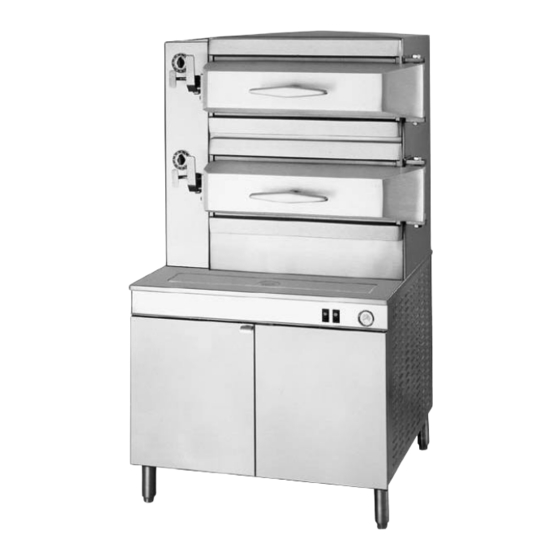
Summary of Contents for Cleveland PDL-2/3
- Page 1 Installation, Operation & Maintenance Manual PRESSURE STEAMERS SERIES: PGM, PEM, PSM, PDM, PDL-2/3 260APC-A...
-
Page 2: Table Of Contents
Operator’s Manual P/N-260APC-A Table of Contents INSTALLATION Correct Installation Water Quality Drain Line Connection Installation Safety Installation Instructions Installation checks Gauge Pressure Reading with No Steam Flow* (Static Pressure) OPERATION Controls and Controls Panels Steam Generator Controls Start-up and Preheat Cooking Operations Startup and Preheat Cooking Operation... -
Page 3: Installation
Operator’s Manual P/N-260APC-A Installation CORRECT INSTALLATION You have purchased the finest Steam Cooking Equipment made. The following information we know will increase the productivity and life span of the equipment. Every product needs proper installation and with a steamer it is critical. The following is some important information you should check on before and during installation of the equipment. -
Page 4: Installation Safety
5. Water Supply. Connect COLD water plumbing to the line strainer (Never conned hot water to the condensate In no event shall Cleveland Range assume any liability for water fill line strainer) Constant flow pressure must be consequential damage or injury resulting from installations... -
Page 5: Installation Checks
Never INSTALLATION CHECKS obstruct the flow of combustion and ventilation air Proper operation of the Cleveland Convection Steamer is Observe all clearance requirements to provide adequate dependent upon proper installation. After the steamer has air openings into the combustion chamber. -
Page 6: Gauge Pressure Reading With No Steam Flow* (Static Pressure)
Operator’s Manual P/N-260APC-A 8. On all steamcoil units, the incoming steam pressure Factory setting may shift due to shaking in transit and must be 35-50 psi. Less than 35 will not effectively resetting will be required after installation. Proper ad- operate the unit. -
Page 7: Operation
The red indicator light in the POWER rocker switch OPERATION turns on and the steam generator begins to fill with Operation of the Cleveland Range Convection Steamer is water units takes about 5 minutes. very easy. Each operator should read and understand the following procedures to effectively start, operate, and shut b. -
Page 8: Cooking Operation
With the steamer off, open the cooking compartment CLEANING instructions, which follow. doors and allows the steamer to cool before cleaning the cooking compartments and their CARE AND CLEANING components. The Cleveland Convection Steamer must he cleaned regularly maintain fast, efficient cooking 3. -
Page 9: Maintenance
Keeping tion and maintenance of your CLEVELAND STEAM PREVENTIVE MAINTENANCE is the key to keeping your COOKER call the Cleveland Service Department at (216) equipment in top condition. There are certain cleaning 4814900. procedures that should be performed on a regular schedule. - Page 10 SteamPro/Convection Pro series steam cookers. The Pump System provides a fast, highly efficient way to descale Cleveland Steam Cookers. The descaling Pump Kit includes a temporary hand-hole plate that is equipped with two descaling ports, one for the inlet and one for the outlet.
- Page 11 NOTE: Overview of Pump Descaling Procedures Only service technicians authorized by Cleveland Range should perform the Below is a summary of the descaling procedure descaling procedure. Read and using the Pump System. The detailed procedure is be familiar with the given on page 3 and 4.
-
Page 12: Equipment Setup
Operator’s Manual P/N-260APC-A Detail Procedure- Using the Descaling Pump System A. Equipment Setup 1. Connect the ½” Feed Hose with attached 1. Turn the Steamer OFF; the boiler will drain union to the bottom of the 3” nipple. automatically 2. Connect the ¾” Drain Hose with the attached 2. - Page 13 Operator’s Manual P/N-260APC-A A. Flushing 1. After the boiler has drained completely, it must be flushed with water. 2. Turn the Steamer back ON; it will begin to Feed Line Hose Drain Line Hose filling. 3. Remove the Pump from the pail. Remove the Drain Hose from the pail.
-
Page 14: Troubleshooting
Operator’s Manual P/N-260APC-A Troubleshooting OPERATORS TROUBLESHOOTING GUIDE This troubleshooting guide includes list Or they should be checked, with the least costly and symptoms that may be encountered during the easiest to repair listed first. The third column also operation and maintenance. The first column on the refers to notes that are grouped at the end of the left (problem) describes these symptoms. -
Page 15: Troubleshooting Notes
2. Proper installation of the Convection Steamer Responsibility of the owner or installer Refer to Cleveland TROUBLESHOOTING NOTES A Licensed Electrician should do repair to external wiring. 1. If problem is inside the steamer, call an authorized... -
Page 16: Cooking Guidelines
Operator’s Manual P/N-260APC-A PRESSURE STEAMER Cooking Guidelines INTRODUCTION Steam cooking is an excellent way to prepare countless foods. With large or small quantities you will find steam cooking to be efficient, economical, fast and convenient. roods can never burn - pans will never boil over - there is no heavy lifting of water pots - no scouring of containers - no waiting for boiling to start. -
Page 17: Frozen Vegetables
Operator’s Manual P/N-260APC-A Under this heading comes a host of dishes not otherwise classified. Cereals, eggs, noodles, spaghetti, rice, macaroni, and dumplings, with variations of each, are just a few. Cooked. frozen convenience foods such as beef stroganoff, pot roast and noodles, chicken fricassee and rice, stuffed cabbage rolls, need only be brought up to serving temperature and then transferred from the pack directly onto the serving plate.











Need help?
Do you have a question about the PDL-2/3 and is the answer not in the manual?
Questions and answers